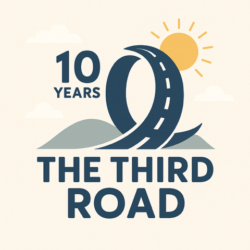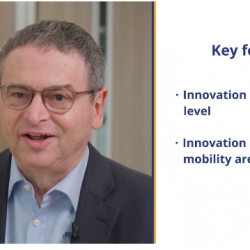Blog
Points of view and news
Rewriting the Rules of Mobility: Lessons from Shanghai
Shanghai didn’t just impress me with its innovations. It invited me to think differently. I recently returned from a compelling trip to Shanghai, where I immersed myself in the future — not a distant vision, but a tangible reality already unfolding on the streets and in the showrooms of China. From testing autonomous vehicles to[…]
10 year ago, The Third Road blog was born.
The Third Road: A Decade of Insight and Vision on Management, Mobility, and Society Introduction Since 2015, The Third Road has documented a transformative journey through the evolving contours of business, technology, and society. Authored from a unique perspective at the intersection of global strategy, cultural sensitivity, and technological foresight, the blog presents a consistent call for[…]
The Wave Is Coming — Are We Ready?
I am in panic. I can’t sleep. The wave is rising—clearly visible from afar. Yet so many act as if nothing is coming. In 1994, during a visit to Alcatel, I heard that phones would become personal—not tied to places. That by 2000, 4 million people in France would use mobile phones. It convinced me and I reported[…]
Successful Innovation and Trend Forecasting: Defying the Consensus and Making a Difference
Successful Innovation and Trend Forecasting: Defying the Consensus and Making a Difference I recently had the opportunity to exchange with a team responsible for product and innovation management at a major corporation. Introduced as the “crazy guy” whose ideas and forecasts defied expectations but generally became reality, I was asked to share insights from my past in innovation management. In this article, I’ll try to articulate some[…]
The Third Road principles explained at Globis No1 MBA in Japan
Lessons from Nissan and Toyota (excerpt of the interview) In this interview, GG explains how mobility has become more complex and how the speed of transformation is unprecedented. In a more global and local world, it will be more and more important to use a management that ensures at the same time a robust and[…]
Self-driving vehicles are not dead, quite the opposite…
We recently read that the 2 car juggernauts VW and Ford decided to drop Argo AI to “focus on more short term objectives” (1) and some jump to the conclusion that the autonomous dream is dead. For example, Max Chafkin in Bloomberg does not hesitate to write it is “going nowhere” (2) The reality is[…]
Why COVID-19 will make brand strategy more important tomorrow than yesterday
When it comes to COVID, there will be a before and an after… many are talking about a new normal and there will be many versions of it… as when is the after. During the pandemic, our lives changed a way we would not have imagined before. It will take time to understand and analyze[…]
“Japanese corporations in a time of disruption. Case of automotive, Nissan and Toyota cultural differences, past and future strategies”
A few weeks ago I gave a lecture at Waseda University to E-MBA students of ESSEC and Mannheim University of three different campuses (Germany, Singapore and France) on transformation in Japanese corporations. It was following a class I did a few years ago, on The Third Road of Management or how to transform companies. The[…]
Going to hit the wall? Where OEM’s need to urgently start transforming…
This year at CES, trends are getting confirmed. Autonomous and smart mobility seems closer than ever. Let’s be clear: Level 5 (the autonomous car you will buy and that can go everywhere) is a Grail that will not be achieved easily. It is now understood by (almost) everyone that you won’t own a car without[…]
The Japanese School of Management: Harmony 和
I.1) The Japanese school, Prioritizing harmony and operational efficiency The Japanese executive is a gardener when the western one is an architect*. This sentence is a good summary of the differences between the two managing system which I call the first two roads of management. When the western executive defines centrally a detailed plan, his[…]
About Us
Why this home page ?
Why this home page? The world has changed and change is just accelerating. This requires a new way of managing global organizations.
There are two schools of thought. The first one, widespread in Japanese companies, relies on permanent operational improvement and independence left to each function and region in a bottom-up way. The other one, mainly taught in most MBA’s, tells us that a limited number of look alike informed people, under the leadership of a C suite executive, decide the strategy of the organization in a top-down way.
Both ignore the fact that the world has become more global and complex at the same time. Customer trends are more homogeneous globally and heterogeneous locally.
There is a different way of managing a global organization that ensures the consistency and alignment of the teams through a strong strategy and the flexibility of the bottom-up approach with initiative taking of each actor.
I have experimented it as an actor and as a leader.
The third road of management combines indeed the strengths of the existing schools of thought. In this new way of operating where the global strategy is crowd-sourced from the teams who will have to execute and the final decision is left to them. It is what we call the “Freedom within a Frame” principle where the frame is collectively defined and the freedom left to the ones who execute.
This principle is based on three beliefs
1. Value creation is more important than cost control alone and emerges from everywhere.
2. People want to be empowered and are much stronger if they are part of the big picture
3. Future winners will need to have a strong global differentiation and high level of flexibility at the same time.
As it is a crowd sourcing and collective approach, it is a learning process and I am therefore expecting as much feedback as possible. Eventually we will write a book on this revolutionary approach.
Thanks for you interest.
GG
Our focus
Reinventing Strategy and marketing leadership in a collaborative world











